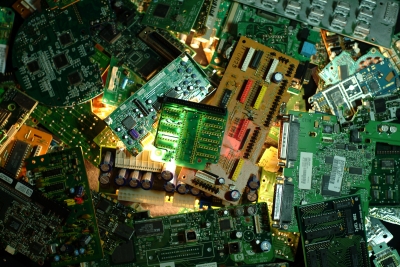The Internet of Things is one of the key trends of the future. Already today, 15 billion things are digitally connected with one another and experts predict an increase to 50 billion devices in the IoT (Internet of Things) by the year 2020. These things include not only computers, tablets and smartphones, but also wearables, consumer electronics and the vehicles we use. However, although this trend offers consumers far greater convenience, it can present recycling companies with a range of difficulties, a fact that was clearly underlined at this year’s International Electronics Recycling Congress IERC 2017 in Salzburg.
When designing our products we already take into account reparability and recyclability, explained Jonathan Perry, Producer Responsibility Compliance Consultant at computer manufacturer Dell, at the IERC press conference today, Wednesday, January 18. “The batteries of our laptops are easily removable and we use recycled plastics from recycled electronics in our housing parts, effectively closing the materials loop. Our experts are looking at future design as well as recycling technologies to ensure that our products remain highly recyclable.”
But there are other materials, that are causing headaches for recyclers. “Apart from the increasingly complex materials, composites of mixed materials, the known legacy heavy metals and halogenated flame retardants, new additives are also beginning to emerge, such as nanoparticles, presenting recycling enterprises with new challenges,” emphasised Dr Mike Biddle, Managing Director of cleantech fund Evok Innovations and Founder and Director of recycler MBA Polymers.
Little research has been done into some of these newest materials with respect to how they behave in traditional recycling processes, he said. It is possible that some of these new materials and additives may also present new dangers with respect to environmental protection and industrial health and safety if not handled with care, particularly during shredding or other size reduction processing. Furthermore, it’s often not easy or even possible for the recycler to know which products have additives that might need special handling as these additives are sometimes kept secret as proprietary.
From a commercial standpoint, too, the years to come are also likely to remain challenging. As Dr Biddle explained, partly responsible are three trends that are actually “good for the planet”. Firstly, there is downsizing, i.e. making electronic devices smaller and smaller. Secondly, life extension, which means the turnover cycles of many devices are beginning to lengthen. And thirdly, there is a certain general trend towards a sharing economy.
“Particularly in major cities, the idea of sharing is becoming more and more popular,” said Biddle. Not every home needs all of the power tools and appliances they have that they perhaps use only a few times a year. Although the sharing economy is a good idea, it definitely also has a downside for e-waste recyclers, as it reduces the number of new devices that need to be produced and therefore also the volume of end-of-life devices that need to be disposed of.
Hence, recyclers again need to position themselves to remain competitive going forward. Above all, they need to make strategic choices in terms of cost savings, innovation, specialisation and internationalisation, stated Norbert Zonneveld, Executive Secretary of the European Electronics Recyclers Association (EERA). “The solution for each type of e-waste treatment operation will be different. Some recyclers are already working on future-proof business models, but there is still a great deal of uncertainty.”
The uncertainty is caused by the differences in implementation of the WEEE regulations across Europe and the difficulties with enforcement, said Zonneveld. “This limits the scope of future-proof business models.”
Another area of concern is the emergence of two parallel worlds. One of the policy makers that aim for a sustainable society with new ideas and the other of operators who experience not enough support in improving the obligations of existing legislation and where it is difficult to make the best efforts for necessary change.
“The two worlds must come together in order to create stability and mobilise financial resources for making the necessary innovations”, stated Zonneveld. “If we do not succeed the race to the bottom will continue where the credibility of regulations is undermined. It is not a new future-business model for recyclers only that is needed, but a holistic improved business model for all stakeholders involved i.e. consumers, producers, take-back systems and recyclers supported by solid harmonized regulations that are enforced. That is what circular economy is about.”











